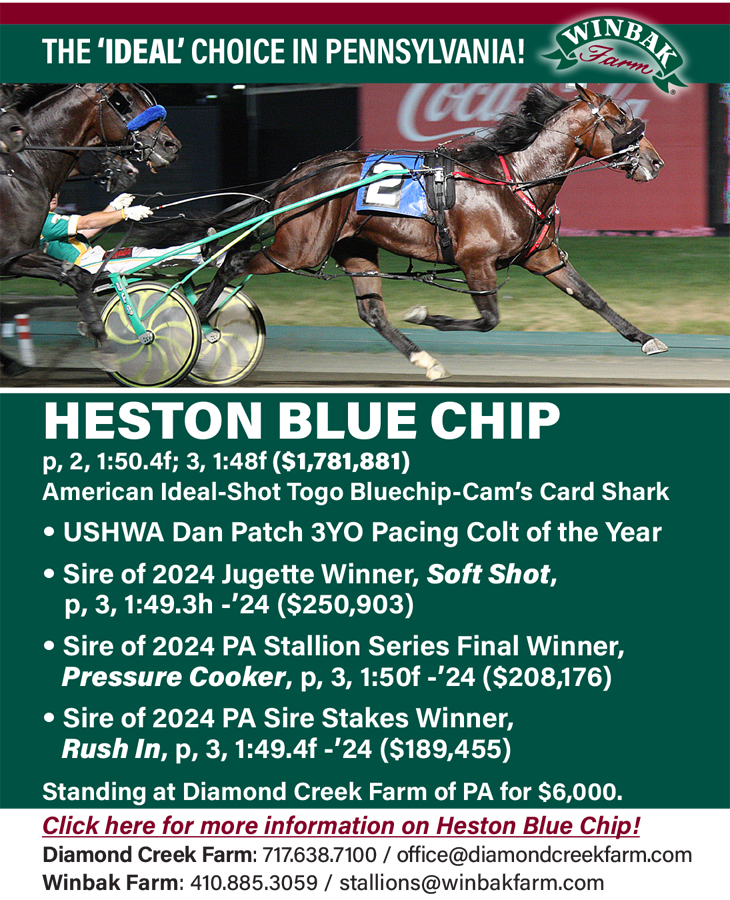
Horse shortage becoming more visible
by Brett Sturman
The steady decline of annual foal crops in harness racing has been well documented over the past couple of decades and is now reaching a point where the impact of the reduction of new horses is visible on the racetrack. The specific reasons for the foal decline from a breeding perspective can be debated, but what we know is that foal numbers won’t be dramatically improving any time soon so the industry and track management need to find a way now to deal with the numbers as they exist today.
The pure logistics of fewer horses juxtaposed against an increasing number of races puts the sport in an eventual perilous situation.
As field sizes are reduced due to fewer horses to go around, the quality of the racing product suffers. The number one driver of handle (amount wagered on races) is field size. So as there become fewer horses to fill the entry boxes at tracks, handle is reduced proportionately and the overall product suffers.
Since casinos run most harness tracks, handle doesn’t particularly matter nearly as much as it used to, although it’s something important to monitor.
Handle will matter to those that live in the world outside of harness racing and who are itching to redirect the slot subsidies from harness racing to things such as education. This might be inevitable at some future point anyway, but when politicians and lawmakers see further evidence that harness racing is an industry that can’t support itself and isn’t gaining any popularity despite being artificially propped up, the process to suspend the slot subsidies will only be accelerated.
As reported by the USTA’s Economic Indicators, total amount wagered to date in 2017 is down 10 per cent year over year to 2016, while total race purses are actually up two per cent. The decrease in the amount wagered in harness racing can be attributed to other things in addition to reduction in field sizes, but one thing we know for sure is that increased purse dollars do not have an impact on wagering.
At point one or another over the past year, horse shortages have caused severe field reductions and cancellations at tracks all over the place, both in the U.S. and in Canada. It has become common for race secretaries to scramble at the last minute in order to fill cards. However, nowhere is the shortage more evident than in the U.S. mid-Atlantic region.
“I think the real crisis will be in the Northeast,” said Meadowlands Racetrack chairman Jeff Gural. “Ohio rotates three tracks. Indiana only has one track and the same in Florida. In Ontario, they have a central government agency that regulates the dates, so they can adjust. Only here with us (the Meadowlands), Yonkers, Saratoga, Pocono and Chester all competing for horses do we have a problem.
“Obviously, without a purse subsidy we are in real danger. This week was the fewest horses ever entered for a weekend and we have short fields and will get killed. Next year will be worse if we don’t work together.”
For the Meadowlands being one of the few tracks left that rely on handle to survive, the reduction in field size becomes a major liability. Meadowlands race secretary Peter Koch affirmed Mr. Gural’s sentiments in that the Northeast is the most affected area. Koch said, “I was looking at the last year’s condition sheets from this time of year and we had between 180 and 200 horses being entered. This week we had 150.” As the Meadowlands is one of the few tracks remaining that relies solely on handle to survive, fewer entries means fewer wagering dollars.
While Gural mentioned Pompano indirectly as not being in the middle of the Northeast crunch (which is true), Pompano is still faced with its own issues as a result of the shortage.
First, because Pompano is isolated from most other tracks it makes it more difficult for horsemen to ship and commit to racing at the track. The minimum number of races as required by law in order for Pompano to put on a race card is eight races. In 2015-16 October through April, Pompano Park had only a single eight-race card. In the same time period from 2016-17, they had 24 different instances in which the track could card only the minimum amount of eight races.
Currently Pompano races three days a week (down five from earlier in the meet) and will be cut back to two days in May as horsemen that raced in winter continue to move back north to other tracks such as Hoosier, Indiana, Hawthorne, Running Aces, and others.
In addition to the reduction in field sizes leading towards lower handle, it leads to a higher degree of uncompetitive races. Without enough horses to properly card races, more often than not fields become unevenly matched since there is only a small set number of horses to work with.
In Canada, Mohawk race secretary Scott McKelvie notes that the track faces challenges as well. “Although our number of entries have held well, we do face a challenge to keep horses in Ontario, and WEG in particular,” McKelvie said.
“The demand for horses appears to have increased as we face losing horses to the U.S. The shortage of horses south of the border and the exchange rate on the dollar are major concerns.”
Similar to the US, the industry in Canada needs to continue to find ways to attract new owners in order to keep a strong product.
The numbers are only going to get worse. It’s purely a matter of mathematics and as fewer new horses are born to replace the existing ones, something is going to have to give.
What we’re left with today is a product that lacks appeal from a betting standpoint and from a fan standpoint. And the sport needs to put forth a good product so that it not only can appeal to people currently in the industry, but so that it can bring in new people as well. It’s the only way to create new fans, new interest and ultimately new owners.
One could argue that a “less is more” approach is needed to improve the quality of the product, but horsepeople will never go for it. Their reasons are understood, but as long as horsepeople want to continue to race, race, race, there will come a point where there won’t be a place to race anymore.
Everyone knows what the problem is but formulating a long-term solution will be much harder.
Last Week’s Bankroll: $941
Total Wagers: $78
Total Return: $59
This Week’s Bankroll: $922
Mohawk, Saturday April 15
Race 4: SHIPPEN OUT attempted a three-wide move last out around stale cover and couldn’t quicken in a race that probably went a bit too quick for him; that’s OK. He drops now while making his second start back on the circuit and he can surprise, I like at a price. BOOMBOOM BALLYKEEL has loads of class and now drops after being caught in a 1:50 mile last out; the likely favorite. MAC RAIDER hasn’t fired in last few but he’s another that drops and trainer/driver Cullen impressed at Woodbine; capable of a wake-up mile at long odds. CHIEF TALKALOT has hit the board in 2 of 3 since shipping here from the Meadowlands; can certainly tow along for a minor share and maybe more.
$15 Win 2
$2 Exacta Box 2-3-4-9
Race 6: DALTON DID IT was encouraging first off the claim last week for Gillis and outraced his odds to finish a decent second. He drops back in for $30K and lands his best post in awhile; probably sharp enough now to give it a go against these. MUSSELSFRMBRUSSELS has been a hot commodity at the claiming box of late and now trainer Puddy takes a turn; often hard used 9-year-old comes off a rare clunker. UFDRAGONS ROCKET has been tearing it up at Rideau of late for Corey Johnson and now returns back to WEG when he was last seen for a tag of $25K; the night he was claimed by the current barn. He’s an obvious short priced contender. PROVEN DESIRE continues to land outside posts but he is capable of speed on occasion; similar tactics coming from that April 1 race?
$25 Win 3
$5 Exacta Box 3 / 1-5












